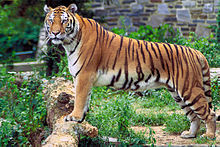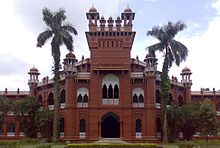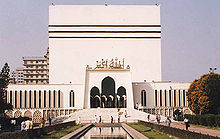Bangladesh, officially the People's Republic of Bangladesh is a
sovereign state located in South Asia. It is bordered by India on all
sides except for a small border with Burma (Myanmar) to the far
southeast and by the Bay of Bengal to the south. Together with the
Indian state of West Bengal, it makes up the ethno-linguistic region of
Bengal. The name Bangladesh means "Country of Bengal" in the official
Bengali language.
The borders of present-day Bangladesh
were established with the partition of Bengal and India in 1947, when
the region became East Pakistan, part of the newly formed nation of
Pakistan. However, it was separated from the western wing by 1,600 km
(994 mi) of Indian territory. Due to political exclusion, ethnic and
linguistic discrimination, and economic neglect by the
politically-dominant West Pakistan, popular agitation grew against West
Pakistan and led to the Bangladesh Liberation War in 1971, which the
Bengali people won with the support of India. After independence, the
new state endured famines, natural disasters and widespread poverty, as
well as political turmoil and military coups. The restoration of
democracy in 1991 has been followed by relative calm and economic
progress.
Bangladesh is a secular republic and a
parliamentary democracy, with an elected parliament called the Jatiyo
Sangshad. It is the eighth most populous country and among the most
densely populated countries in the world. A high poverty rate prevails,
although the United Nations has acclaimed Bangladesh for achieving
tremendous progress in human development. Geographically, the country
straddles the fertile Ganges-Brahmaputra Delta and is subject to annual
monsoon floods and cyclones.

Bangladesh lies between latitudes 20° and 27°N, and longitudes 88° and 93°E. Bangladesh
is in the low-lying Ganges–Brahmaputra River Delta or Ganges Delta.
This delta is formed by the confluence of the Ganges (local name Padma
or Pôdda), Brahmaputra (Jamuna or Jomuna also known as "Yamuna"), and
Meghna rivers and their respective tributaries. The Ganges unites with
the Jamuna (main channel of the Brahmaputra) and later joins the Meghna
to eventually empty into the Bay of Bengal. The alluvial soil deposited
by these rivers has created some of the most fertile plains in the
world. Bangladesh has 57 trans-boundary rivers, making water issues
politically complicated to resolve – in most cases as the lower riparian
state to India. Most parts of Bangladesh are less than 12 m (39.4 ft)
above the sea level, and it is believed that about 10% of the land would
be flooded if the sea level were to rise by 1 m (3.28 ft).
In
south east Bangladesh experiments have been done since the sixties to
'build with nature'. By implementing cross dams, the natural accretion
of silt has created new land. With Dutch funding, the Bangladeshi
government began to help develop this new land in the late 1970s. The
effort has since become a multiagency operation building roads,
culverts, embankments, cyclone shelters, toilets and ponds, as well as
distributing land to settlers. By fall 2010, the program will have
allotted some 27,000 acres (10,927 ha) to 21,000 families.
The
highest point in Bangladesh is in Mowdok range at 1,052 m (3,451 ft) in
the Chittagong Hill Tracts to the southeast of the country. Cox's
Bazar, south of the city of Chittagong, has a beach that stretches
uninterrupted over 120 kilometres (75 mi).

Straddling the Tropic of Cancer, Bangladeshi climate is
tropical with a mild winter from October to March, a hot, humid summer
from March to June. A warm and humid monsoon season lasts from June to
October and supplies most of the country's rainfall. Natural calamities,
such as floods, tropical cyclones, tornadoes, and tidal bores occur
almost every year,combined with the effects of deforestation, soil
degradation and erosion. The cyclones of 1970 and 1991 were particularly
devastating. A cyclone that struck Bangladesh in 1991 killed some
140,000 people.
In September 1998, Bangladesh saw the most severe
flooding in modern world history. As the Brahmaputra, the Ganges and
Meghna spilt over and swallowed 300,000 houses, 9,700 kilometres (6,027
mi) of road and 2,700 kilometres (1,678 mi) of embankment 1,000 people
were killed and 30 million more were made homeless with 135,000 cattle
killed, 50 square kilometres (19.3 sq mi) of land destroyed and 11,000
kilometres (6,835 mi) of roads damaged or destroyed. Two-thirds of the
country was underwater. There were several reasons for the severity of
the flooding. Firstly, there were unusually high monsoon rains.
Secondly, the Himalayas shed off an equally unusually high amount of
melt water that year. Thirdly, trees that usually would have intercept
rain water had been cut down for firewood or to make space for animals.
Bangladesh
is now widely recognized to be one of the countries most vulnerable to
climate change. Natural hazards that come from increased rainfall,
rising sea levels, and tropical cyclones are expected to increase as
climate change, each seriously affecting agriculture, water &
food security, human health and shelter It is believed that in the
coming decades the rising sea level alone will create more than 20
million climate refugees. Bangladeshi water is contaminated with arsenic
frequently because of the high arsenic contents in the soil. Up to 77
million people are exposed to toxic arsenic from drinking
water.Bangladesh is among the countries most prone to natural floods, tornadoes and cyclones.
Flora and Fauna

A major part of the coastline comprises a marshy jungle, the Sundarbans,
the largest mangrove forest in the world and home to diverse flora and
fauna, including the Royal Bengal Tiger. In 1997, this region was
declared endangered.The Magpie Robin is the National Bird of Bangladesh
and it is common and known as the Doyel or Doel (Bengali: দোয়েল). It is
a widely used symbol in Bangladesh, appearing on currency notes and a
landmark in the city of Dhaka is named as the Doyel Chatwar (meaning:
Doyel Square).The national flower of the country is water lily, which is
known as Shapla. The national fruit is jackfruit (Artocarpus
heterophyllus) , which in Bengali is known as Kathal. In late 2010, the
Bangladeshi government selected the Mango tree as the national tree.
Demographics

Recent (2007–2010) estimates of Bangladesh's population range from 150 to 164 million and it is the 8th most populous nation in the world. In 1951, the population was 44 million. It is also the most densely populated large country in the world, and it ranks 11th in population density, when very small countries and city-states are included. A striking contrast is offered by Russia which has a slightly smaller population spread over a land area that is 120 times larger than Bangladesh. Bangladesh's population growth was among the highest in the world in the 1960s and 1970s, when the country swelled from 50 to 90 million. With the promotion of birth control in the 1980s, the growth rate has slowed. The population is relatively young, with 60% being 25 or younger and 3% being 63 or older. Life expectancy is 63 years for both males and females.
The overwhelming majority of Bangladeshis are ethnic
Bengalis, comprising 98% of the population. The remainder are mostly
Biharis and indigenous tribal groups. There is also a small but growing
population of Rohingya refugees from Myanmar around Cox's Bazaar, which
Bangladesh seeks to repatriate to Myanmar. The indigenous tribal peoples
are concentrated in the Chittagong Hill Tracts in the southeast. There
are 13 tribal groups located in this region, the largest being the
Chakma. The Hill Tracts region has been a source of unrest and
separatism since and before the inception of Bangladesh Outside the Hill
Tracts, the largest tribal groups are the Santhals and Garos (Achiks),
while smaller groups include the Kaibartta, Meitei, Mundas, Oraons, and
Zomi.
Languages
Nearly all Bangladeshis speak Bangla as their mother tongue and it is
the official language. It is an Indo-Aryan language of Sanskrit origin
with its own script. English is used as a second language among the
middle and upper classes. English is also widely used in higher
education and the legal system. Historically, laws were written in
English and translated into Bengali until 1987 when the procedure was
reversed.The Bihari population speaks Urdu, which was also the language
associated with the government prior to separation from Pakistan.
Religion
Education

The educational system in Bangladesh is three-tiered and highly subsidized. The government of Bangladesh operates many schools in the primary, secondary, and higher secondary levels. It also subsidizes parts of the funding for many private schools. In the tertiary education sector, the government also funds more than 15 state universities through the University Grants Commission.
Primary (from grades 1 to 5), Secondary (from grades 6 to 10), Higher Secondary (from grades 11 to 12) and tertiary.The five years of lower secondary education concludes with a Secondary School Certificate (SSC) Examination. Students who pass this examination proceed to two years of Higher Secondary or intermediate training, which culminate in a Higher Secondary Certificate (HSC) Examination.Education is mainly offered in Bangla, but English is also commonly taught and used. A large number of Muslim families send their children to attend part-time courses or even to pursue full-time religious education, which is imparted in Bangla and Arabic in madrasahs.
Bangladesh conforms fully to the Education For All (EFA) objectives, the Millennium Development Goals (MDG) and international declarations. Article 17 of the Bangladesh Constitution provides that all children between the ages of six and ten years receive a basic education free of charge.
Universities in Bangladesh are mainly categorized into three different types: Public university (government owned and subsidized), Private University (private sector owned universities), and International University (operated and funded by international organizations )
Bangladesh has some thirty public and forty-five private universities. National University has the largest enrollment amongst them and University of Dhaka (estd.1921) is the oldest university of the country. Bangladeshi universities are accredited by and affiliated with the University Grants Commission (UGC), a commission created according to the Presidential Order (P.O. No 10 of 1973) of the Government of the People's Republic of Bangladesh.
Bangladesh conforms fully to the Education For All (EFA) objectives, the Millennium Development Goals (MDG) and international declarations. Article 17 of the Bangladesh Constitution provides that all children between the ages of six and ten years receive a basic education free of charge.
Universities in Bangladesh are mainly categorized into three different types: Public university (government owned and subsidized), Private University (private sector owned universities), and International University (operated and funded by international organizations )
Bangladesh has some thirty public and forty-five private universities. National University has the largest enrollment amongst them and University of Dhaka (estd.1921) is the oldest university of the country. Bangladeshi universities are accredited by and affiliated with the University Grants Commission (UGC), a commission created according to the Presidential Order (P.O. No 10 of 1973) of the Government of the People's Republic of Bangladesh.
Miss Bangladesh:












No comments:
Post a Comment